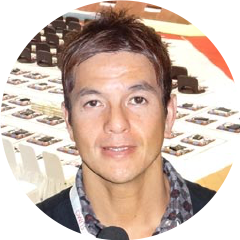
According to ancient texts, sumo goes back about 1,500 years. Originally, it was a court function, closely tied to the Shinto religion. In the old days, it was performed at shrines, to pray for bountiful harvests and world peace. Sumo began to take its present form in the 18th century, as commercial tournaments were organized across the country.
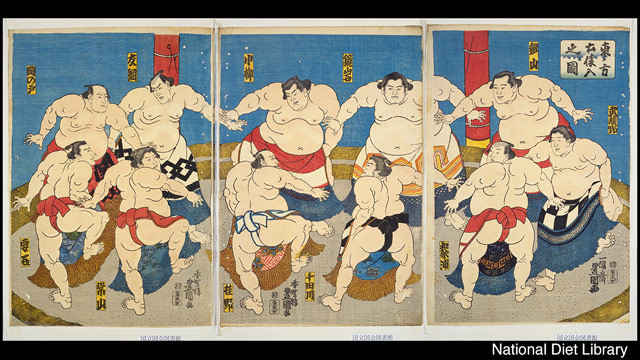
The rules of sumo are simple. A rikishi (wrestler) wins a bout by forcing his opponent out of the ring or by making him touch the ground with any part of the body except the soles of the feet, using a technique such as a throw.
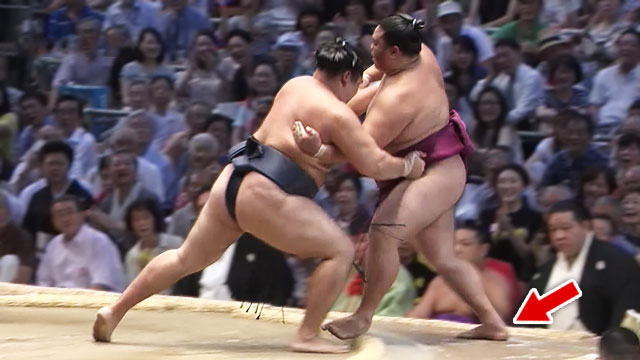
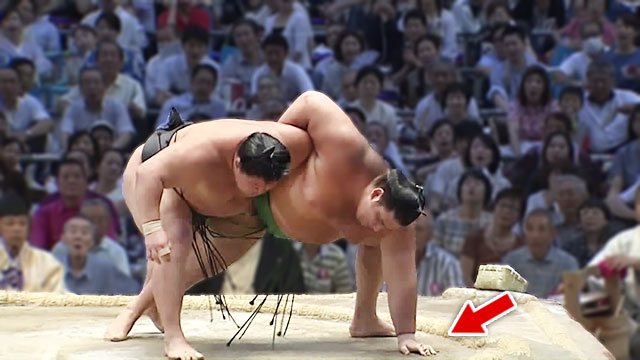
Six grand tournaments take place each year, starting with the New Year's tourney in January in Tokyo. The Spring tourney is held in March in Osaka, the Summer tourney in May in Tokyo, the Nagoya tourney in July, the Autumn tourney in September in Tokyo, and the final one of the year--the Kyushu tourney-- is held in Fukuoka in November.
Each grand tournament lasts 15 days. All the hard work and dedication of the rikishi is aimed at these 90 matches per year.
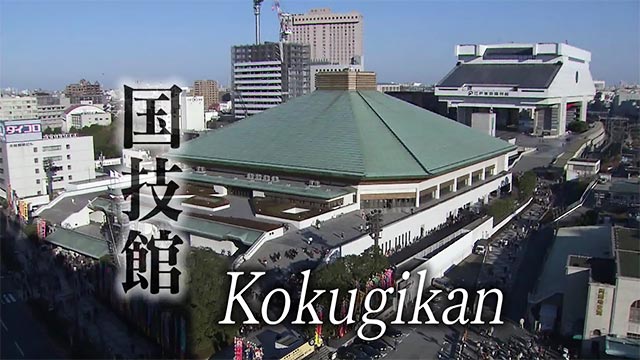 Sumo Stadium in Tokyo
Sumo Stadium in TokyoSumo wrestlers are called “rikishi” which means “men of strength” and the mage or the topknot is considered a sacred part of their body pretty much like the samurai warriors in the old days. That’s why the rule exists to prohibit wrestlers from pulling each other’s topknot.
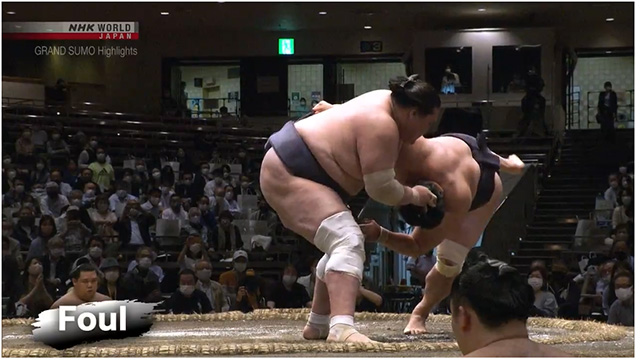 In May 2021, Terunofuji committed a foul by pulling Myogiryu’s hair.
In May 2021, Terunofuji committed a foul by pulling Myogiryu’s hair.Before each match, a yobidashi—announcer— steps into the ring. He’s not singing, but rather calling out the names of the rikishi who are about to compete. This has been a tradition of sumo for over 200 years. Yobidashi use volume and intonation to add to the appeal of their introductions. One of the top-division yobidashi, Rikinojo, told me that acquiring the skills takes at least three years of apprenticeship and hard work. Yobidashi have to chant loudly enough to be heard at a distance. So, they hold a white fan to prevent any spittle from falling onto the sacred dohyo.
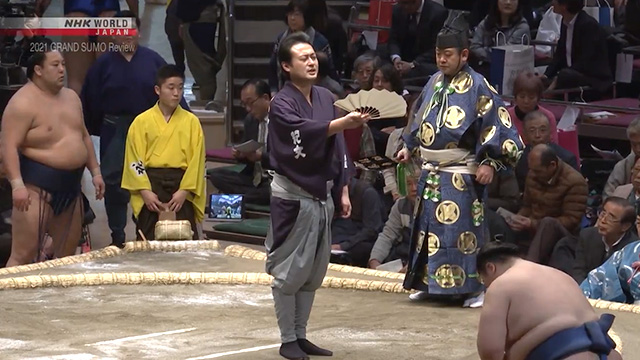 Yobidashi RIKINOJO is calling out the names of next combatants.
Yobidashi RIKINOJO is calling out the names of next combatants.In principle, a wrestler cannot move to a different stable. Currently 42 stables, heya, are in operation. Once you enter a particular heya, you’re going to be a member until you retire. So, choosing the right one is a critical step for each rikishi who turns pro. The stablemasters try to sign up as many promising wrestlers as they can in order to make their heya competitive and successful. Recruiting is an important part of every oyakata stablemaster’s job.
The false starts are called matta, there’s no limit to them. However, a wrestler who has three in a row will be summoned to the judges’ room to receive a warning or, sometimes, a reprimand. Matta usually occurs because the two wrestlers are not in sync.
Both hands have to properly touch the dohyo. The match starts by mutual consent, which makes things difficult for the wrestlers. Each of them has his own game plan and wants to gain an early advantage. But a rule is a rule, so the wrestlers have no choice but to strictly follow the tachiai procedure.
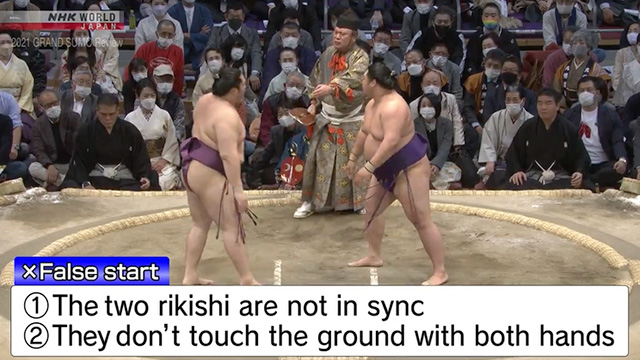
No. No matter how small and light a rikishi may be, he fights his scheduled opponent. That's one of the intriguing aspects of the sport.
According to data for the July 2016 tournament, the heaviest rikishi in the Makunouchi division is Ichinojo. He tips the scales at 211 kilograms. The tallest is Ikioi, who measures 194 centimeters. At the other end are Kitaharima at 126 kg and Takekaze at 171 cm.
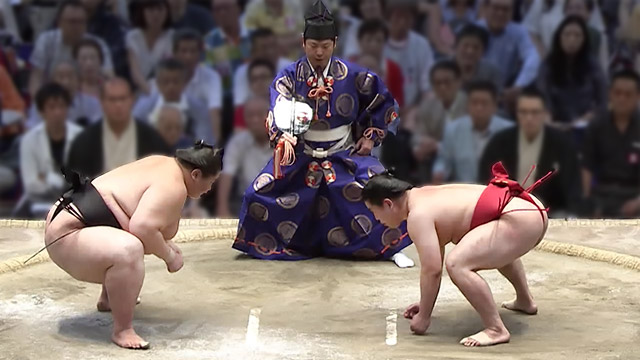 Left: Ichinojo (The heaviest rikishi)
Left: Ichinojo (The heaviest rikishi)The rankings are all written on a sheet of thin paper called the Banzuke, the official listing. At the top stand the Yokozuna grand champions, followed by the Ozeki, Sekiwake, Komusubi and Maegashira. Rikishi who are in these five ranks compete in Makunouchi, the highest division. Below Makunouchi are Juryo, Makushita, Sandanme, Jonidan and Jonokuchi. Thus, six divisions in all. Only the rikishi who compete in the top two divisions, Makunouchi and Juryo, are called sekitori and considered full-fledged rikishi. They're also the only ones who receive monthly salaries. Those in the other four divisions are apprentices.
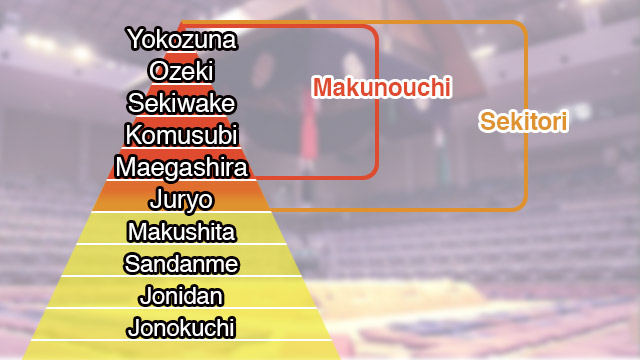
The dohyo ring is 4.55 meters across. It rises 66 centimeters above the ground. A new dohyo is made prior to each grand tournament by the Yobidashi, sumo's all-purpose working staff. It takes three days.
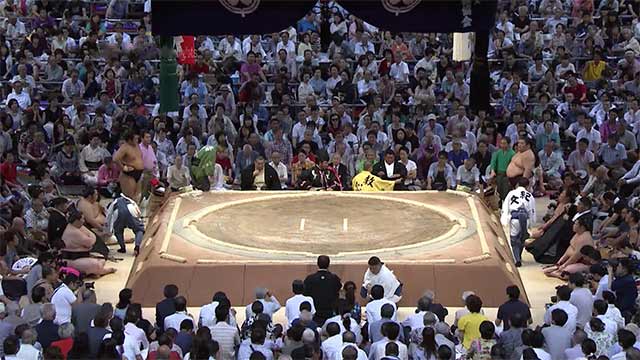
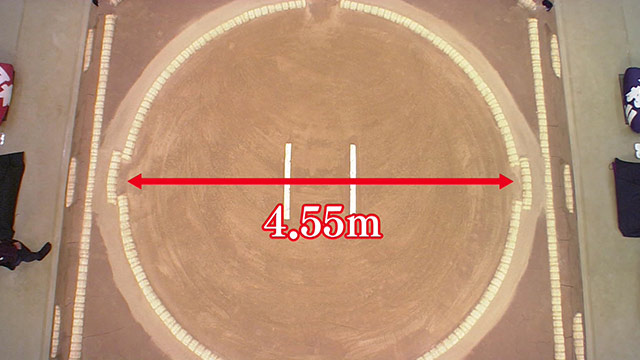
Entry is limited to boys and men who have finished nine years of schooling. They must be at least 167 centimeters tall and weigh at least 67 kilograms. Anything less fails the physical exam.
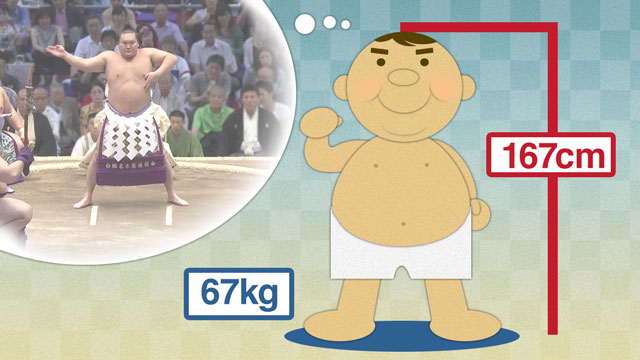
In order to move up to the higher ranks, a rikishi has to finish grand tournaments with kachikoshi, more wins than losses. Conversely, a losing record lead to demotion.
Professional sumo has a total of six divisions. The top Makunouchi division is subdivided into five ranks: Yokozuna at the pinnacle, followed by Ozeki, Sekiwake, Komusubi, and Maegashira.
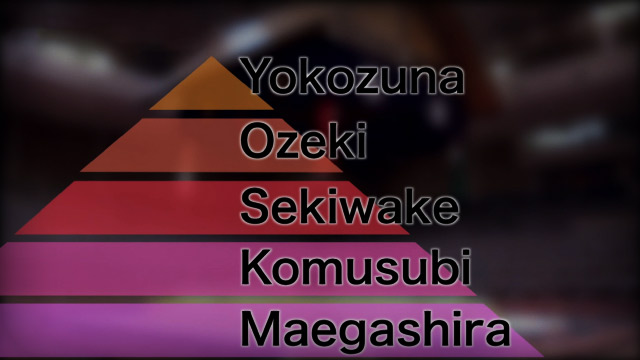 Ranks of the top Makunouchi division
Ranks of the top Makunouchi divisionBecoming a Yokozuna or Ozeki is especially difficult.
A candidate has to put up impressive records for several consecutive tournaments. A potential Ozeki, for example, must score double digit winning records for at least three consecutive tournaments. Making it from Ozeki to Yokozuna is harder still, generally requiring two consecutive tournament championships or something equally impressive.
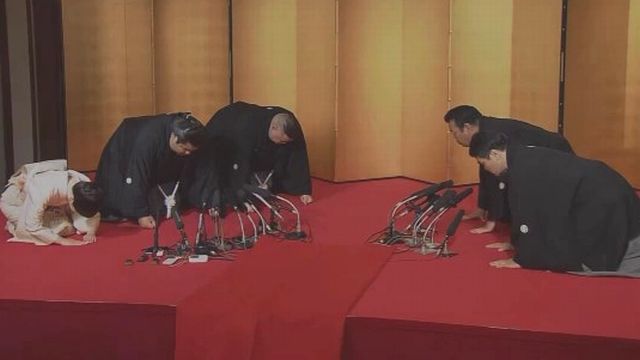 Ceremony to announce promotion to ozeki
Ceremony to announce promotion to ozekiOnce a rikishi joins the elite corps of Yokozuna, he’ll never face demotion, even if he ends up with a losing record in a tournament or withdraws due to injury. However, if a Yokozuna can’t maintain his supremacy and fails to win a championship within a reasonable period of time, he’ll be expected to resign. To stay at the top, a Yokozuna has to continually prove he deserves to be there.
An Ozeki has a little more breathing room. He won’t lose his status because of just one losing tournament. Two in a row, though, will send him back down to the rank of Sekiwake.
In general, when a rikishi who’s yet to secure a kachikoshi withdraws because of injury, he gets demoted. Even after a good showing, a rikishi can’t rest on his laurels. The next tournament will always determine which way he’s headed.
Yes, nothing in the Japan Sumo Association rules prohibits a person from another country from becoming a pro. The first foreign-born rikishi to make the top division was Takamiyama, from Hawaii. He made his debut in the 1968 January tournament and, in July of 1972, became the first rikishi from outside Japan to win a Makunouchi top division championship. Since then, other rikishi have come from a variety of places, including Bulgaria, Brazil, and Egypt.
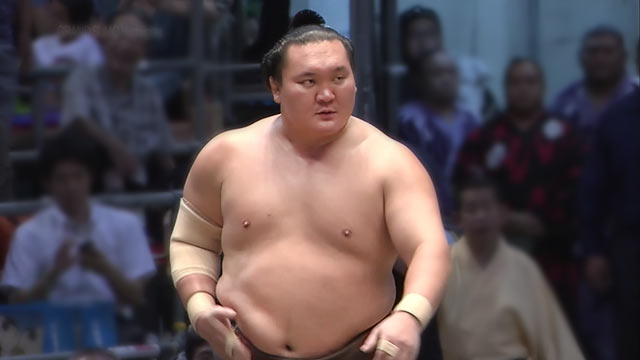 Hakuho (Mongolia)
Hakuho (Mongolia)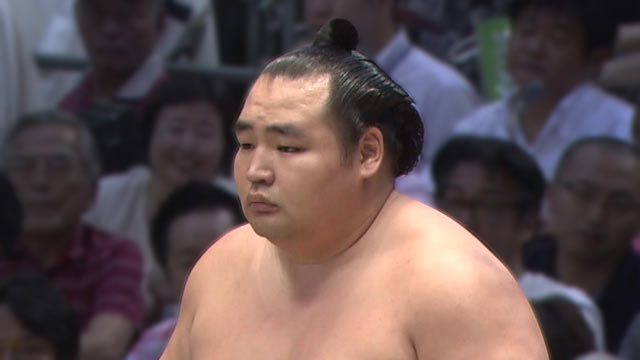 Kakuryu (Mongolia)
Kakuryu (Mongolia)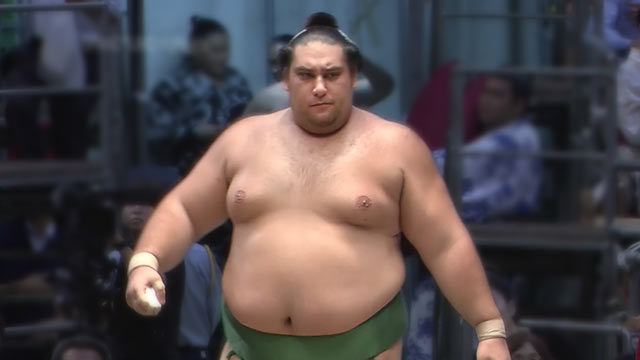 Kaisei (Brazil)
Kaisei (Brazil)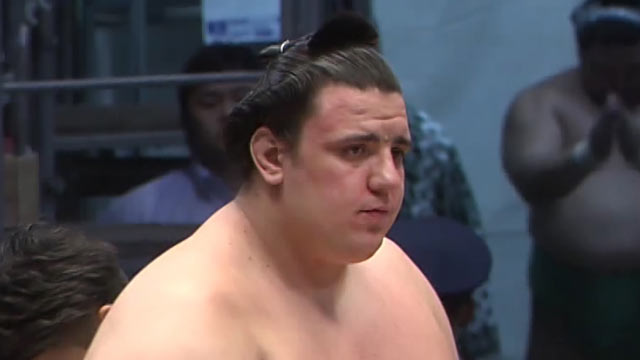 Aoiyama (Bulgaria)
Aoiyama (Bulgaria)Sumo rikishi generally eat only twice a day. The schedule is said to enable them to ingest more food and calories in each meal, thus helping them get bigger quickly. The morning practice starts around 6. When it ends at 11, the rikishi eat their first meal of the day. Invariably, it's chanko-nabe, a hot pot stew filled with nutritious ingredients such as meat and vegetables. Big bowls of rice are also necessary to make their bodies bigger.
Taking a nap after the meal is important to bulking up. The next meal comes in the evening. For dinner, some rikishi eat chanko-nabe again, but most go for ordinary dishes. Rikishi who want to increase their weight quickly may add a late-night snack.
Although a rikishi ingests lots of calories from the meals, he maintains fitness and mobility by engaging in long and hard workouts on a daily basis.
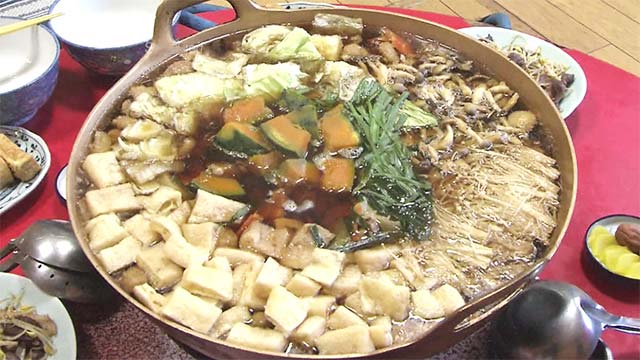
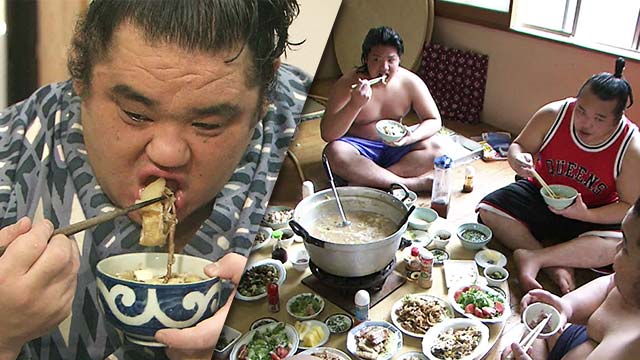
Sumo has 82 kimarite, winning techniques. Among the most frequently used are Yorikiri (frontal force out), Oshidashi (frontal push out), Uwatenage (over-arm throw), Shitatenage (under-arm throw), Hatakikomi (hand slap down), and Hikiotoshi (hand pull down).
Some offensive moves are prohibited, such as pulling a topknot. A rikishi who commits that sort of foul is penalized with a loss.
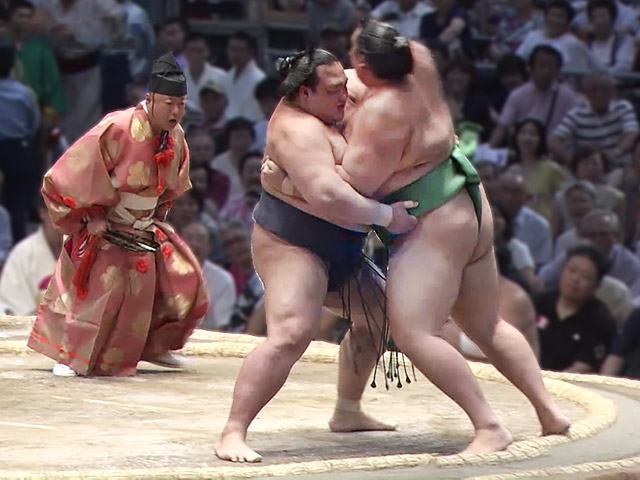 Yorikiri (frontal force out)
Yorikiri (frontal force out)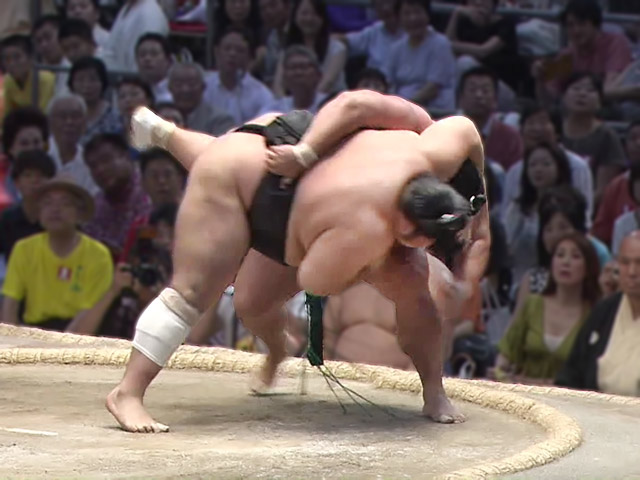 Shitatenage (under-arm throw)
Shitatenage (under-arm throw)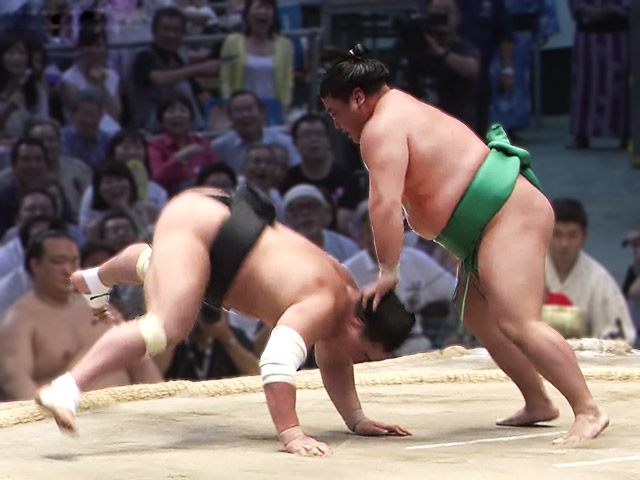 Hatakikomi (hand slap down)
Hatakikomi (hand slap down)They're throwing salt. The sumo dohyo, the ring, is considered to be a sanctuary for the deity. Salt is thought to have cleansing power, and rikishi throw it to purify the ring. About 45 kilograms of salt are used on each day of a grand tournament.
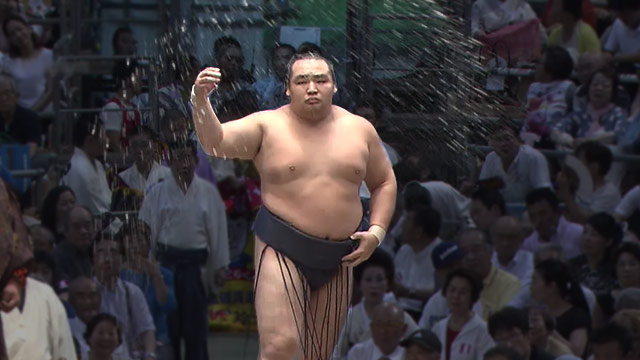
Before two rikishi engage in a tachiai, they repeat what's called shikiri a few times. Shikiri is a preparation routine. Four minutes of shikiri time is allowed in the top Makunouchi division; three minutes in the second-tier Juryo division. When the time expires, the timekeeper—one of the five judges—will raise his hand to let the gyoji referee know. Then, the gyoji will nod to the rikishi.
The most important rule of the tachiai is that the wrestlers must put both hands/fists on the dohyo to start. If they don't, the gyoji or the judges will stop the bout and have them do the tachiai again, until they get it right. Also, the rikishi themselves start the match by mutual consent; no one orders them to begin.
At tachiai, you'll see many approaches. For example, a rikishi might slap an opponent's face, step to the side, try a leg trip, and apply a brutal forearm to the chin or a stiff arm to the throat . . . all in the first few seconds. He does this to gain full advantage at the get-go, because it's said that 80 to 90 percent of the time, the outcome of a match is decided by the initial charge.
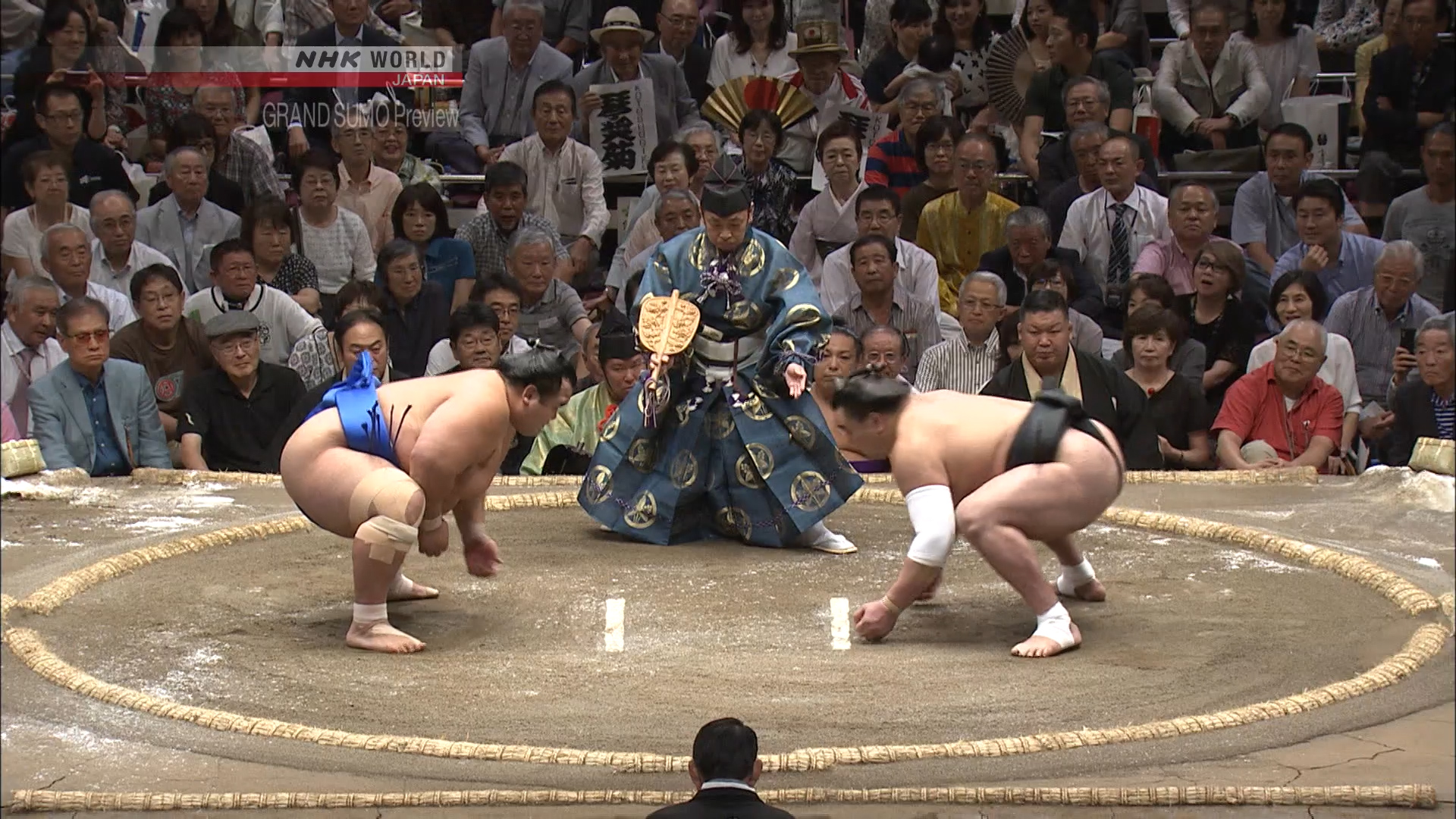
The official banzuke list of rankings is renewed every tournament. All the rikishi in six divisions are divided into east and west, and east is higher for each rank. For instance, the East Maegashira #1 rikishi is higher than the West Maegashira #1 rikishi. If there are more than three Yokozuna, the top one is East Yokozuna. Number 2 is West Yokozuna. The third highest will also be listed as East Yokozuna but beneath the name of #1. During a tournament, the schedule alternates on a daily basis. On odd-numbered days, everything starts from the east side. On even-numbered days everything begins from the west. So, on Day 1, the ring announcer will call out the name of the east side rikishi first followed by the west side rikishi. Of course, depending on how he does, a rikishi may find himself on the other side next time.
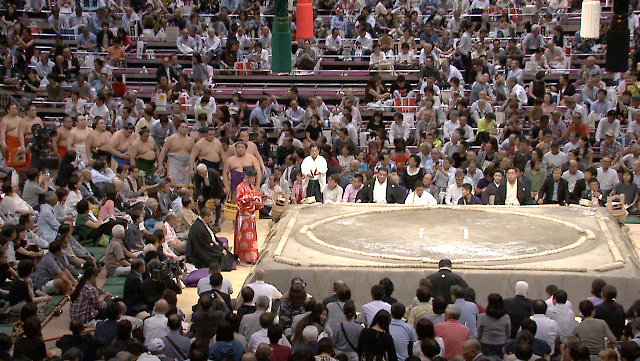 East side rikishi to enter the ring
East side rikishi to enter the ring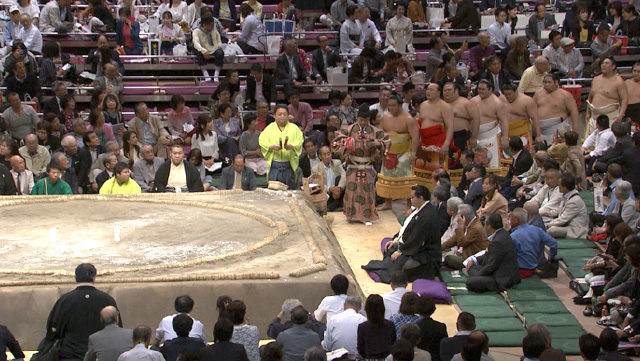 West side rikishi to enter the ring.
West side rikishi to enter the ring.A rikishi can leave a tournament if an injury or illness makes him unable to compete. If this happens after the opponent for the next day’s match has been announced, it goes down as a loss; the other wrestler gets a fusensho forfeit win. Any other absence is counted as a loss too, even though nobody receives credit for winning. So, a rikishi with 7 wins, 4 losses, and 4 absences would end up with a makekoshi losing record.
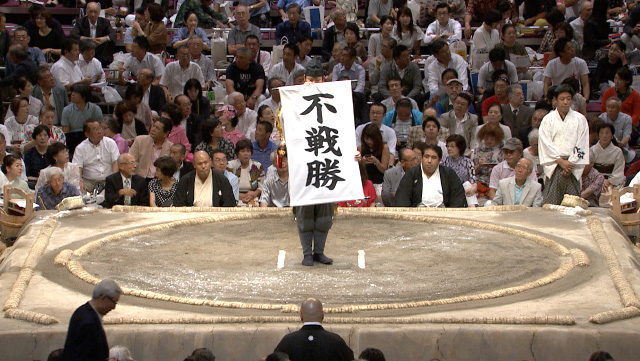 Announcement of fusensho or forfeit win.
Announcement of fusensho or forfeit win.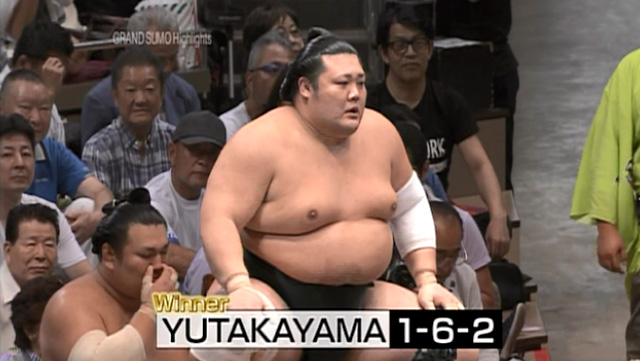 1wins, 6 losses and 2 absences, makekoshi record
1wins, 6 losses and 2 absences, makekoshi recordInside the envelope is Kenshokin, the prize money given to the winner. The money is usually provided by businesses. It's a way to publicize a company and its products. The company names are announced inside the arena, and their corporate banners are shown on the dohyo before a bout. A popular rikishi such as a Yokozuna grand champion, who attracts a lot of attention on TV, gets a substantial amount for a victory. 1.5 million yen is not at all unusual.
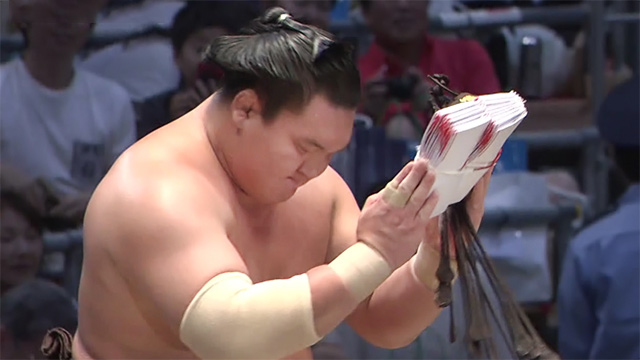
In the Makunouchi top division, the tournament champion is rewarded with 10 million yen. The winner of Shukunsho (the Outstanding Performance Award), Kantosho (the Fighting Spirit Prize), and Ginosho (the Technique Prize) each receive 2 million.
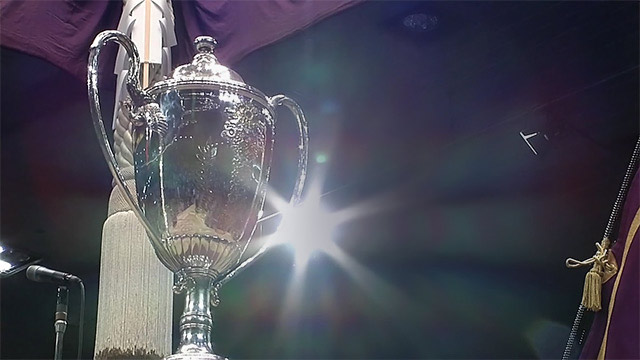
Officials from the judges division decide who faces whom at the Bout Composition meetings. During a grand tournament, they gather every morning around 11. The following day's pairings are announced around noon and posted on sumo association web site. The final day's matches are decided at a much later hour on Day 14, as officials try to come up with the best possible match-ups.
A rikishi doesn't fight the same opponent twice in a tournament except in a playoff, when two men are tied for first place after the 15 regulation bouts. Each rikishi usually takes on opponents of similar ranks. So, a Yokozuna faces off against fellow Yokozuna, Ozeki, and others near the top of the banzuke, the official listing of ranks. In the same way, those near the bottom of the division usually confront rikishi in that area. If they're in contention for the title late in the tournament, they'll be pitted against some of the top wrestlers. That ensures that anyone who wins the championship really earns it.
All the rikishi aim to become an Oyakata, stable master. However, not everyone can reach that goal. The number of positions is limited to 105. Also, an Oyakata must be a Japanese citizen. So, anyone not born that way must naturalize. Four foreign-born former rikishi are currently stable masters Musashimaru from the US, Kotooshu from Bulgaria, Kyokutenho from Mongolia, Sokokurai from China. All four are now Japanese nationals.
That's not all. Only those who had impressive rikishi careers can aspire to Oyagata status. Ozeki or Yokozuna are eligible, as are those who fought at least one tournament at sanyaku: Sekiwake or Komusubi. Competing in at least 20 tournaments in the top Makunouchi division is another route. Fighting either in the top division and/or the second-tier Juryo division for a combined 30 tournaments is yet another.
Those who can't make it to stable master might become Wakaimonogashira, the men who take care of young apprentices, or Sewanin, who work to make the grand tournaments go smoothly. Here too, though, the number of positions is limited. As a result, most rikishi are unable to stay in the sumo association after they call it quits. One popular calling is opening a chanko restaurant. Chanko is the hotpot stew that wrestlers eat to get bigger and stronger. It's delicious and nutritious, making it popular with other people too.
The scarcity of jobs within the sumo association puts even more pressure on wrestlers during the years they're in the ring. Their record affects what happens then and the rest of their lives.
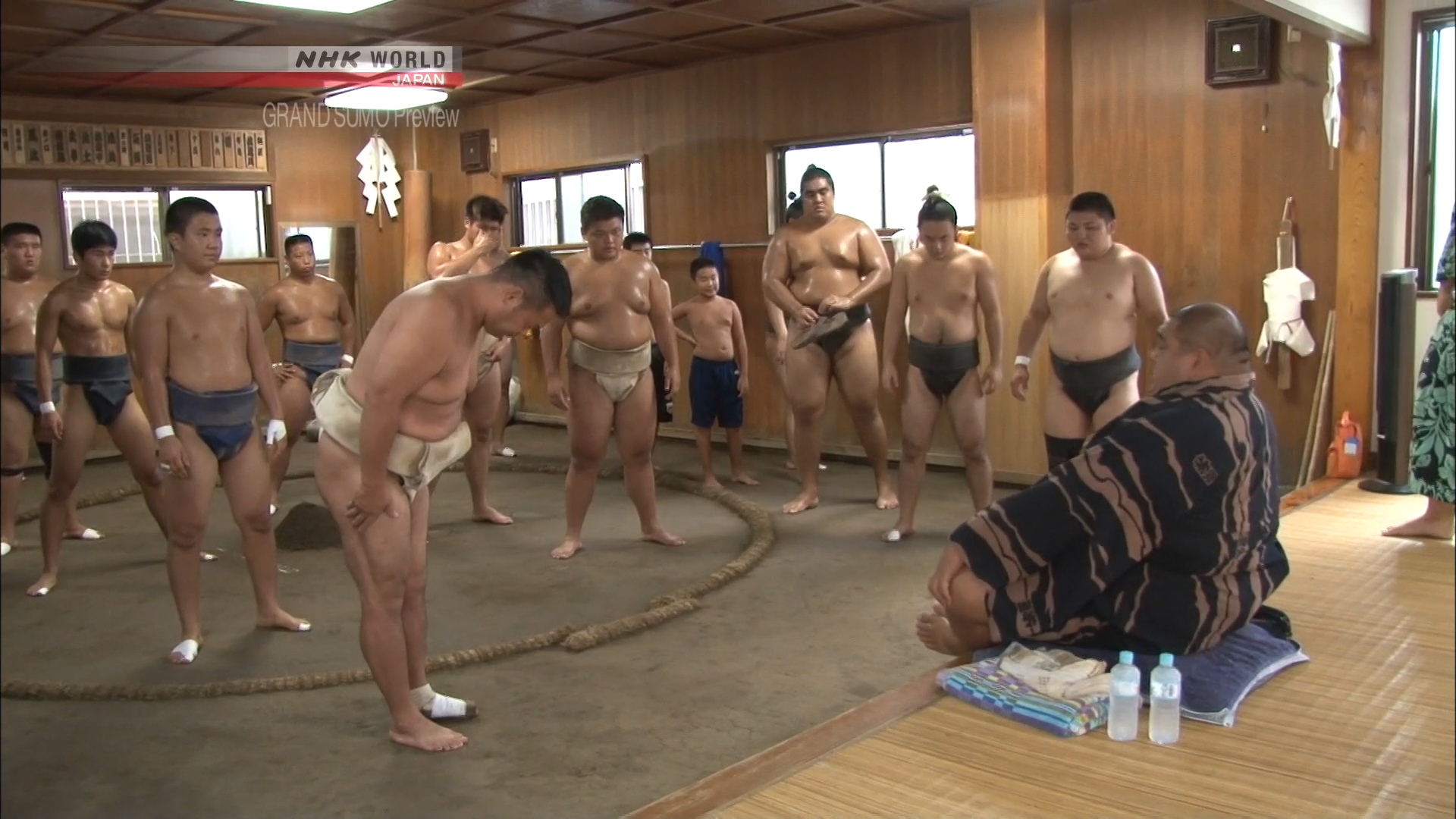
Attacking an opponent by going forward often is the major factor in deciding the winner of a match. It's the primary reason for Takakeisho getting the victory over Enho. Takakeisho used a fierce pushing attack to take Enho all the way to the edge of the ring. Enho tried to counter by getting his right hand on Takakeisho's belt and forced Takakeisho to step out. However, Enho's body was already bending back, on the verge of hitting the deck, when he made his desperation move. Takakeisho's foot seemed to have gone out just as Enho landed on the clay, but Takakeisho was the one who was attacking and moving forward at all times. That turned out to be the deciding factor for granting the victory to Takakeisho.
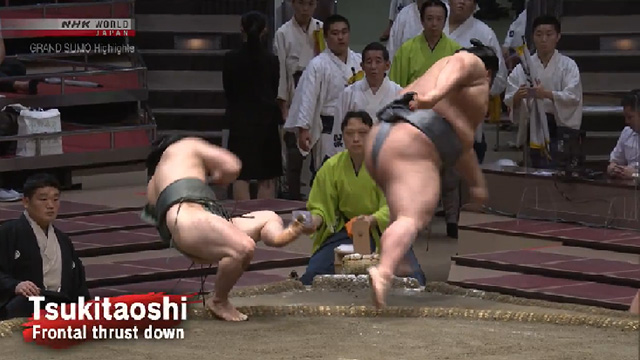 TAKAKEISHO attacked and won while Enho's body was flying
TAKAKEISHO attacked and won while Enho's body was flyingWhat's shinitai?
From time to time you'll hear the word shinitai. The literal meaning is “dead body.” In the sumo context, it refers to a wrestler's body being in an impossible position to recover and rally. When someone is declared to be shinitai, it's safe to say he'll be given the loss.
A judges' conference takes place at the center of the ring, but a wireless device connects them with two video replay officials. In that way, the judges can be more confident of making the right call.
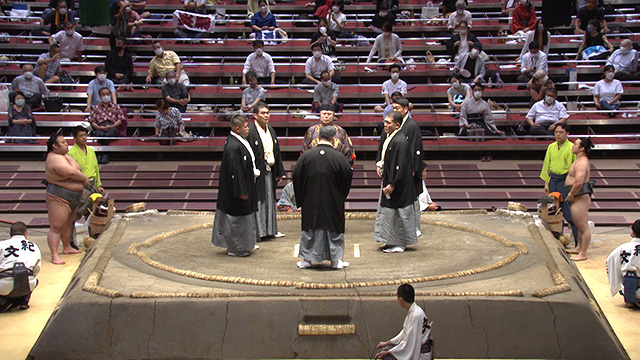 The judges discuss on TAKAKEISHO-ENHO in July 2020
The judges discuss on TAKAKEISHO-ENHO in July 2020When two wrestlers are tied for first place after all the regulation bouts have taken place, they face off in a playoff on that final day. The winner of the playoff becomes the tournament champion.
When six wrestlers are tied at the top after 15 days, they take part in a six-way playoff. It's been known to happen. First, three matches are held. The winners advance to a three-way playoff. That continues until someone defeats two different opponents in a row to claim the title.
A tournament winner has just one or two losses. How many can a wrestler have and still claim the Emperor's Cup?
In the absence of tied records, the wrestler with the most wins after 15 days claims the championship, no matter how many or how few that may be. Sometimes the champion goes 15-0. Other times, just 11 wins might be enough. It all depends on how spirited the competition has been and how many upsets took place.
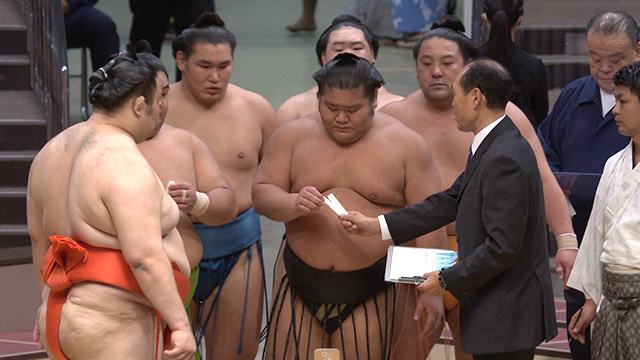 Drawing for the 6-way playoff in Juryo division, July 2020
Drawing for the 6-way playoff in Juryo division, July 2020